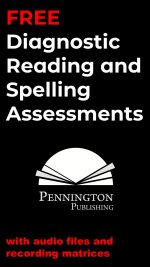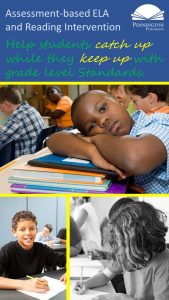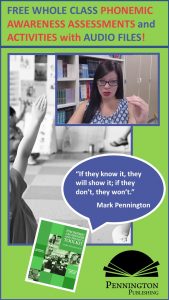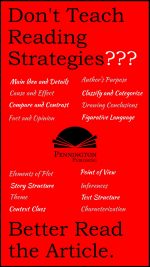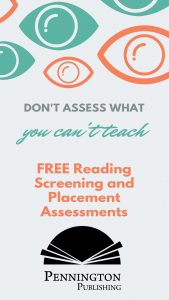Diagnostic Reading and Spelling Assessments
Elementary, secondary, and adult English language-arts and reading intervention teachers need comprehensive literacy assessments to pinpoint strengths and weaknesses for individual students and their classes. Following are reliable and valid reading and spelling assessments which perform the dual function of placement and diagnosis.
The diagnostic design of the assessments does not simply indicate that a student has reading problems. Instead, the test items are specific and teachable. Additionally, the assessments are not mere random samples, but are comprehensive. For example, rather than using simply one long /a/ item to determine whether the student has mastered vowel sound phonics and the spelling pattern, all long /a/ sound-spelling patterns are assessed. Thus, the teacher can target instruction to what the student needs and eliminate instruction for that which the student has already mastered.
The assessments may be administered individually or whole class. Two recording matrices are included: one for reading and one for spelling. The recording matrices provide the teacher with simple one-look progress monitoring.
Most of the assessments also include an audio file to standardize test administration and to permit the teacher to monitor students during the assessment session. The audio flies are helpful to assess new students and for make-ups due to student absences.
The author, Mark Pennington, is a MA reading specialist, author, and publisher. His Teaching Reading Strategies and Sam and Friends Guided Reading Phonics Books BUNDLE include instructional resources targeted to each assessment item. Perfect for assessment-based learning. Note that the author also provides the same resources keyed to the literacy assessments in the literacy centers (stations) instructional design. See product description below and also download the FREE instructional resource from the program.
Phonemic Awareness and Alphabetic Awareness
Use these five phonemic awareness (syllable awareness, syllable rhyming, phonemic isolation, phonemic blending, phonemic segmenting) and two awareness assessments (upper and lower case identification and application) to determine reading readiness. Each of the seven assessments is administered whole class. The author’s reading intervention program includes corresponding phonemic awareness and alphabetic awareness activities to remediate all deficits indicated by the assessments.
- Syllable Awareness Assessment (5:48 Audio File)
- Syllable Rhyming Assessment (5:38 Audio File)
- Phonemic Isolation Assessment (5:54 Audio File)
- Phonemic Blending Assessment (5:53 Audio File)
- Phonemic Segmenting Assessment (5:21 Audio File)
Vowel Sounds Phonics Assessment *
Use this comprehensive 52 item whole class assessment to determine your students’ mastery of short vowels, long vowels, silent final e, vowel digraphs, vowel diphthongs, and r-controlled vowels. The assessment uses nonsense words to test students’ knowledge of the sound-spellings to isolate the variable of sight word recognition. Unlike other phonics assessments, this assessment is not a random sample of phonics knowledge. The Vowel Sounds Phonics Assessment includes every common vowel sound-spelling. Thus, the results of the assessment permit targeted instruction in any vowel sound phonics deficits. The author’s reading intervention program includes corresponding worksheets and small group activities to remediate all deficits indicated by this assessment.
- Vowel Sounds Phonics Assessment (10:42 Audio File)
Consonant Sounds Phonics Assessment *
Use this comprehensive 50 item whole class assessment to determine your students’ mastery of consonant digraphs, beginning consonant blends, and ending consonant blends. The assessment uses nonsense words to test students’ knowledge of the sound-spellings to isolate the variable of sight word recognition. Unlike other phonics assessments, this assessment is not a random sample of phonics knowledge. The Consonant Sounds Phonics Assessment includes every common sound-spelling. Thus, the results of the assessment permit targeted instruction in any consonant sound phonics deficits. The author’s reading intervention program includes corresponding worksheets and small group activities to remediate all deficits indicated by this assessment.
- Consonant Sounds Phonics Assessment (12:07 Audio File)
Sight Words (Outlaw Words) Assessment
Use this 99 item whole class assessment to determine your students’ mastery of the most common non-phonetic English words. The author’s The author’s reading intervention program includes small group activities to remediate all deficits indicated by this 15-minute assessment. The program includes an Outlaw Words fluency article which uses all assessment sight words. The program also provides sight word game card masters and individual sets of business card size game cards in the accompanying Reading and Spelling Game Cards.
Rimes (Word Families) Assessment
Use this comprehensive 79 item whole class assessment to determine your students’ mastery of the most common English rimes. Memorization and practice of these word families such as ack, eck, ick, ock, and uck can supplement an explicit and systematic phonics program, such as found in the author’s reading intervention program. Experienced reading teachers know that different students respond differently to reading instruction and some remedial students especially benefit from learning onsets (such as consonant blends) and rimes. The program includes small group activities to remediate all deficits indicated by this 15-minute assessment. The program also provides rimes game card masters and individual sets of business card size game cards in the accompanying Reading and Spelling Game Cards.
Use this 49 item whole class assessment to determine your students’ mastery of the most common Greek and Latin prefixes and suffixes. Memorization and practice of these high utility affixes will assist with syllabication, spelling, and vocabulary development. The author’s reading intervention program provides Greek and Latin prefix and suffix game card masters and individual sets of business card size game cards in the accompanying Reading and Spelling Game Cards.
The “Pets” expository fluency passage is leveled in a unique pyramid design: the first paragraph is at the first grade (Fleish-Kincaid) reading level; the second paragraph is at the second grade level; the third paragraph is at the third grade level; the fourth paragraph is at the fourth grade level; the fifth paragraph is at the fifth grade level; the sixth paragraph is at the sixth grade level; and the seventh paragraph is at the seventh grade level. Thus, the reader begins practice at an easier level to build confidence and then moves to more difficult academic language. As the student reads the fluency passage, the teacher will be able to note the reading levels at which the student has a high degree of accuracy and automaticity. Automaticity refers to the ability of the reader to read effortlessly without stumbling or sounding-out words. The 383 word passage permits the teacher to assess two-minute reading fluencies (a much better measurement than a one-minute timing). The author’s reading intervention program provides 43 expository animal fluency articles and 43 corresponding animal comprehension worksheets tiered st the third, fifth, and seventh grade reading levels along with links to YouTube modeled readings, recorded at three different reading speeds.
Reading Assessments Recording Matrix
Diagnostic Spelling Assessment *
Use this comprehensive diagnostic assessment to pinpoint all sound-spelling patterns learned from kindergarten through eighth grade. This 102 item eighth grade test pinpoints spelling deficits and equips the teacher to individualize instruction according to the assessment-data. The author’s program provides 102 targeted worksheets to remediate each unknown assessment sound-spelling. Each worksheet includes a spelling sort and formative assessment.
- Diagnostic Spelling Assessment (22:38 Audio File)
- Spelling Patterns Assessment Matrix
* Placement Assessments

The Science of Reading Intervention Program
The Science of Reading Intervention Program: Word Recognition includes explicit, scripted instruction and practice with the 5 Daily Google Slide Activities every reading intervention student needs: 1. Phonemic Awareness and Morphology 2. Blending, Segmenting, and Spelling 3. Sounds and Spellings (including handwriting) 4. Heart Words Practice 5. Sam and Friends Phonics Books (decodables). Plus, digital and printable sound wall cards and speech articulation songs. Print versions are available for all activities. First Half of the Year Program (55 minutes-per-day, 18 weeks)
The Science of Reading Intervention Program: Language Comprehension resources are designed for students who have completed the word recognition program or have demonstrated basic mastery of the alphabetic code and can read with some degree of fluency. The program features the 5 Weekly Language Comprehension Activities: 1. Background Knowledge Mentor Texts 2. Academic Language, Greek and Latin Morphology, Figures of Speech, Connotations, Multiple Meaning Words 3. Syntax in Reading 4. Reading Comprehension Strategies 5. Literacy Knowledge (Narrative and Expository). Second Half of the Year Program (30 minutes-per-day, 18 weeks)
The Science of Reading Intervention Program: Assessment-based Instruction provides diagnostically-based “second chance” instructional resources. The program includes 13 comprehensive assessments and matching instructional resources to fill in the yet-to-be-mastered gaps in phonemic awareness, alphabetic awareness, phonics, fluency (with YouTube modeled readings), Heart Words and Phonics Games, spelling patterns, grammar, usage, and mechanics, syllabication and morphology, executive function shills. Second Half of the Year Program (25 minutes-per-day, 18 weeks)
The Science of Reading Intervention Program BUNDLE includes all 3 program components for the comprehensive, state-of-the-art (and science) grades 4-adult full-year program. Scripted, easy-to-teach, no prep, no need for time-consuming (albeit valuable) LETRS training or O-G certification… Learn as you teach and get results NOW for your students. Print to speech with plenty of speech to print instructional components.
Get the SCRIP Comprehension Strategies FREE Resource:
![]()
Get the Diagnostic ELA and Reading Assessments FREE Resource:
Literacy Centers, Reading, Spelling/Vocabulary, Study Skills
